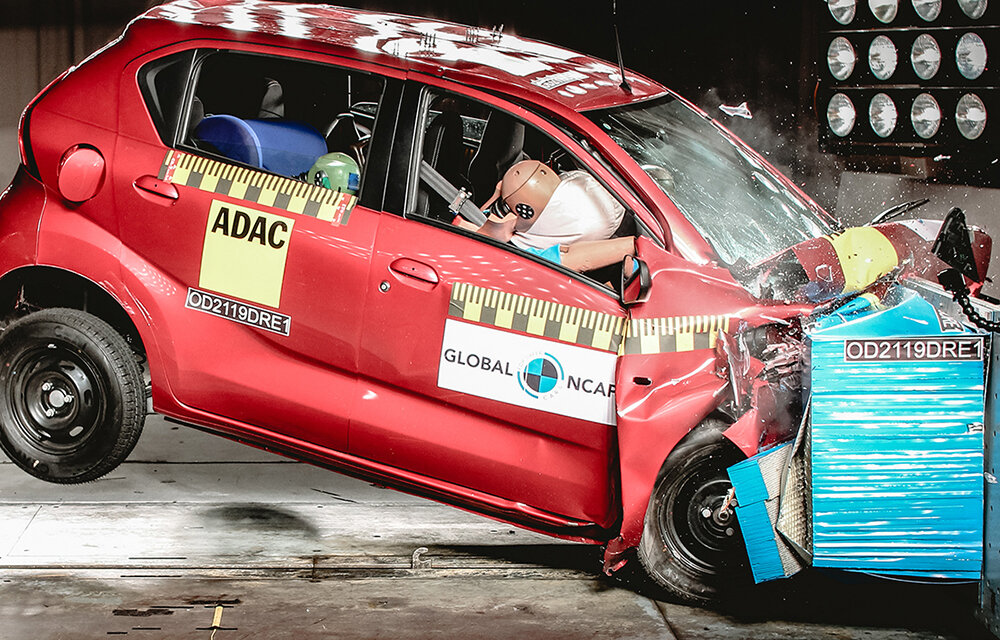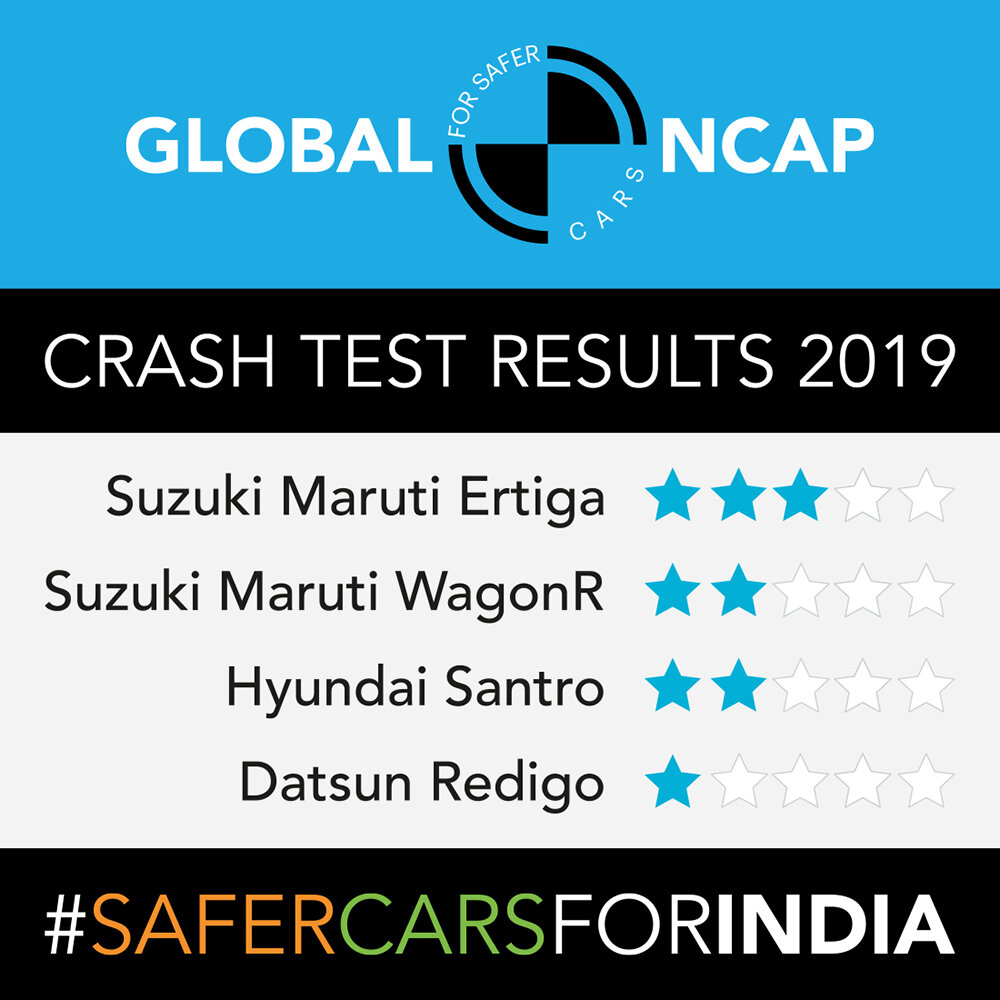Three Star Ertiga And One Star Redigo In Latest Crash Test Results For India
Global NCAP launches the sixth round of #SaferCarsForIndia crash test results today with the welcome support of the FIA Foundation and Bloomberg Philanthropies. Results for the four models tested range from three stars to a single star for adult occupant protection.
The models tested are: the Suzuki Maruti Ertiga, Suzuki Maruti WagonR, Hyundai Santro and the Datsun Redigo.
Global NCAP chose the entry-level version of each model and as a result only the Ertiga was fitted with at least two airbags as standard while the other models offered only a driver airbag. The results highlight significant differences in adult occupant protection in cars that meet the latest Indian government vehicle technical regulations.
David Ward, CEO and President of Global NCAP said,
“The latest results in our #SaferCarsforIndia crash tests show a mixed safety performance, and disappointingly, there are no five star performers. The Suzuki Maruti Ertiga achieves a creditable three stars for both adult and child occupant protection, but it’s obvious to us that more can and should be done to improve overall protection levels for cars sold in the market.
“The Indian government’s crash test standards are clearly helping to eliminate any new zero star cars from the market, and we will continue to work with them to ensure the push of regulatory requirements is complimented by the pull of consumer awareness, encouraging the demand for ever higher levels of safety.”
Suzuki Maruti Ertiga
The Ertiga achieved three stars for adult occupant protection and three stars for child occupant protection. The Ertiga offers two frontal airbags as standard. Its structure was rated as a borderline unstable performance which can and should be improved. Its footwell area was rated as unstable and pedals displacement showed risks to the lower legs of the driver. Head and neck protection for adult occupants was good. Chest protection for passenger was good and driver chest received marginal protection. The passenger pretensioner failed to work properly. Child occupant protection showed poor results for the 18 month old dummy with the CRS installed forward facing while global best practice indicates a rearward facing position offers better protection for this age group. The Ertiga offers standard ISOFIX anchorages. Overall, the Ertiga achieved three stars for child occupant protection. The Ertiga offers standard two Seat Belt Reminders (SBR) in the front seats. It is surprising that this car is not offering 3 point belts for all occupants.
Suzuki Maruti WagonR
The WagonR achieved two stars for adult occupant protection and two stars for child occupant protection. The WagonR offers only a driver frontal airbag as standard. Its structure was rated as unstable. Its footwell area was rated as unstable and pedal displacement showed some risk to the lower legs of the driver. Head protection for adult occupants was good. Neck protection for driver was good and adequate for passenger. Chest protection was weak for both front passengers leading to limitations in the SBR points achieved by this model. Child occupant protection showed poor results mainly for the 3 year old dummy as its Child Restraint System (CRS) broke during the impact and the head impacted the front seat. Chest protection for the 18month old dummy was low despite being installed rearward facing.
The WagonR offers standard two SBR in the front seats but its points were not considered for the final rating as the front passenger chest received weak protection. It is surprising that this car is not offering 3 point belts for all occupants.
Hyundai Santro
The Santro achieved two stars for adult occupant protection and two stars for child occupant protection. The Santro offers only a driver frontal airbag as standard. Its structure was rated as unstable. Its footwell area was rated as unstable. Head and neck protection for adult occupants was good. Chest protection was weak for the driver and marginal for the passenger leading to a limitation of the SBR points achieved by this model for the driver. Child occupant protection showed poor results mainly because the manufacturers did not recommend a CRS for the test. The dynamic performance was poor as the head of the 3 year old showed contact during the impact. There was limited protection for the 3 year old neck while the 18 month old received acceptable protection. The Santro offers standard driver SBR but its points were not considered for the final rating as the chest of the driver received weak protection. It is surprising that this car is not offering 3 points belts for all occupants.
Datsun RediGO
The RediGo achieved just one star for adult occupant protection and two stars for child occupant protection. The RediGo offers only a driver frontal airbag as standard. Its structure was rated as unstable. Its footwell area was rated as unstable. Head protection for driver was adequate due to steering wheel displacements. Head protection for passenger was good. Driver and passenger neck protection was good. Chest protection was poor for the driver and marginal for the passenger. The poor protection of the driver chest means that there is a high probability of life threatening injuries. Poor protection for any of the critical body regions, in this case the chest, limits the star rating to one star for the adults. The RediGo does not offer SBR in the front seats and, even if it had, the result would remain a single star. SBR points are limited as the chest is brown or red. Child occupant protection showed poor results mainly because of the contact of the head of the 18 month old with the front seat and for the exposed head of the 3 year old dummy during the impact. The static rear 3 point belts created difficulties in the proper and safe installation of a CRS. It is surprising that this car is not offering 3 point belts with automatic retractors for all occupants.
Global NCAP awards a separate child safety rating to each car in order to highlight the different levels of protection vehicles provide to passengers on the rear seats. Global NCAP tests a combination of the car and that Child seat recommended by the car manufacturer. Because the only safe way for young children to travel is properly restrained in a child seat, the assessment checks how compatible the car is with the child seats recommended by the manufacturer, as well as the protection provided in the crash test. The three tested vehicles offer ISOFIX as standard which is a desirable improvement however the different tests showed poor performances of the CRS in terms of child occupant protection. Airbags are not a substitute for seatbelts, passengers must always wear seatbelts.
None of the models offered three-point seatbelt for all passengers. Lap belts in the middle position makes it impossible to properly and safely install a CRS and offers a much lower protection than a three point belts for adults.
Suzuki Maruti Ertiga (2 airbags)
Read the full crash test report
Watch the crash test video
Download crash test image
Suzuki Maruti WagonR (driver airbag)
Read the full crash test report
Watch the crash test video
Download crash test image
Hyundai Santro (driver airbag)
Read the full crash test report
Watch the crash test video
Download crash test image
Datsun Redigo (driver airbag)
Read the full crash test report
Watch the crash test video
Download crash test image
Note to Editors
Safer Cars For India Campaign
The #SaferCarsForIndia Campaign was launched by Global NCAP in 2014 with the objective of promoting safer vehicles in the country. Between 2014 and 2018 Global NCAP has completed more than twenty-nine safety assessments which have acted as an important catalyst in the safety improvement of Indian cars. www.globalncap.org






